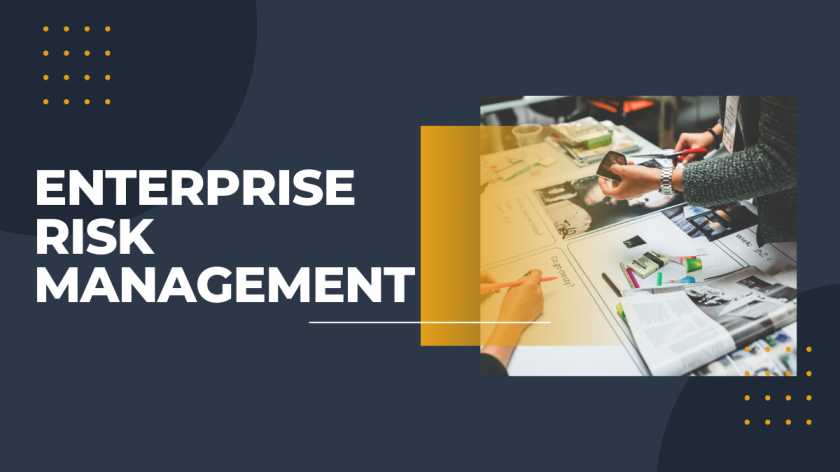Last updated on September 20th, 2024 at 06:35 am
Enterprise Risk Management (ERM) is a strategic methodology that allows enterprises to systematically identify, assess, manage, and monitor risks across the entire enterprise. Unlike traditional risk management processes, which often treat risks in silos, ERM embeds risk considerations into every aspect of business operations, ensuring alignment with broader business objectives. This comprehensive approach ensures that risks are managed proactively rather than reactively, enabling businesses to navigate uncertainties with greater effectiveness.
Understanding what is risk management and the importance of a cohesive risk management process is particularly vital in the investment banking sector. Investment banks operate within a highly dynamic and complex environment, facing challenges such as market volatility, regulatory changes, and global economic fluctuations.
ERM provides a structured framework to manage these risks, safeguarding the bank’s assets and maintaining operational stability. By incorporating ERM into their decision-making processes, investment banks can enhance their resilience to risks, seize opportunities, and sustain a competitive advantage in the market.
Let us now get into the specifics of enterprise risk management.
The Importance of Enterprise Risk Management
Understanding ERM is crucial for professionals in the investment banking industry because of the wide array of risks they face. These include market risk, which involves the potential for losses due to fluctuations in market prices; credit risk, associated with the possibility of a counterparty defaulting on a financial obligation; operational risk, which can arise from failures in internal processes, systems, or human errors; and regulatory risk, driven by the need to comply with stringent and constantly evolving financial regulations.
Having in-depth knowledge of ERM enables investment banking professionals to effectively anticipate, mitigate, and respond to these risks, ensuring the long-term sustainability and profitability of their institutions. Moreover, as the financial industry continues to evolve with advancements in technology and regulatory pressures, the role of ERM will become even more critical in navigating these complexities.
The Significance of Enterprise Risk Management
Before moving forward, let’s get to the most obvious question, how ERM is beneficial for the financial industry?
Here’s a brief overview:
Holistic Risk View: ERM provides organisations with a comprehensive understanding of their risk landscape, allowing them to view risks in an integrated manner rather than in silos. This holistic perspective ensures that all potential risks, whether financial, operational, or strategic, are considered and managed together, reducing the likelihood of oversight.
Enhanced Decision-Making: By embedding the risk management process into strategic decision-making, ERM helps organisations make informed decisions that consider potential downsides and opportunities. This leads to better alignment between risk appetite and business objectives, ensuring that decisions contribute to long-term success.
Improved Risk Response: ERM allows organisations to anticipate and prepare for potential risks before they materialise, leading to quicker and more effective responses. This proactive approach minimises the impact of adverse events, thereby protecting the organisation’s assets, reputation, and financial stability.
Regulatory Compliance: For industries like investment banking, where regulatory requirements are stringent, ERM ensures compliance with laws and regulations. By systematically addressing regulatory risks, organisations can avoid penalties, legal issues, and the associated reputational damage.
Increased Resilience: With ERM, organisations build resilience against unexpected disruptions. By continuously monitoring and managing risks, they are better positioned to withstand financial downturns, market volatility, and other external shocks, ensuring business continuity.
Stakeholder Confidence: Effective ERM fosters confidence among stakeholders, including investors, customers, and regulators. Demonstrating a robust risk management framework reassures stakeholders that the organisation is well-managed and capable of navigating uncertainties, which can lead to increased investment and trust.
Competitive Advantage: Organisations that excel in ERM can turn the risk management process into a competitive advantage. By identifying and exploiting opportunities that others might avoid due to perceived risks, these organisations can achieve higher returns and maintain a strong market position.
Core Components of Enterprise Risk Management
The COSO (Committee of Sponsoring Organisations of the Treadway Commission) framework outlines eight key components that guide companies in developing effective enterprise risk management practices.
Here’s a breakdown of these eight essential components:
1. Internal Environment
The internal environment refers to the corporate culture and overall atmosphere within an organisation, shaped by its employees. This environment influences how the company approaches risk, including the management’s attitude toward risk-taking and the organisation's overall risk tolerance. While upper management or the board of directors typically sets the tone, the entire workforce’s actions reflect this environment, reinforcing the company's risk philosophy throughout the organisation.
2. Objective Setting
As a company defines its mission, it must establish clear objectives that align with its goals and risk tolerance. For instance, if a company sets ambitious strategic objectives, it must recognise and prepare for the associated risks, both internal and external. This alignment ensures that the company’s strategies are realistic and manageable within its risk capacity, such as by hiring specialised staff to navigate regulatory challenges in new markets.
3. Event Identification
Identifying events that could significantly impact the business is crucial. These events could be positive, offering growth opportunities, or negative, potentially threatening the company’s survival. ERM emphasises the need to pinpoint key areas of vulnerability, such as operational risks (like natural disasters that disrupt business) or strategic risks (such as regulatory changes that could render a product line obsolete).
4. Risk Assessment
After identifying potential risks, the next step is to assess their likelihood and financial impact. This involves evaluating both the direct risks (e.g., a natural disaster making an office unusable) and residual risks (e.g., employees feeling unsafe returning to work). Although challenging, ERM encourages companies to quantify risks by estimating the probability of occurrence and the potential financial consequences, which aids in making informed decisions.
5. Risk Response
Companies can respond to risks in four primary ways:
- Avoiding Risk: The company stops the risky activity altogether, choosing to forgo any associated benefits. For example, discontinuing a product line that poses significant risks.
- Reducing Risk: The company continues the activity but takes steps to lessen the likelihood or impact of the risk. This might involve improving quality control measures to reduce product-related risks.
- Sharing Risk: The company maintains the current risk profile but collaborates with a third party, like purchasing insurance, to share potential losses.
- Accepting Risk: The company evaluates the risks and decides whether the potential benefits outweigh the need for mitigation. For instance, continuing operations without significant changes despite the risks.
6. Control Activities
Control activities refer to the procedures and policies a company implements to manage risks effectively. These activities are categorised into two types:
- Preventative Controls: Designed to prevent undesirable events from occurring. For example, physical locks or access codes prevent unauthorised entry into secure areas.
- Detective Controls: These are set up to identify when a risk has materialised, allowing for corrective action. An example is an alarm system that alerts management when unauthorised access occurs.
7. Information and Communication
Effective ERM relies on robust information systems that capture and analyse data relevant to the company’s risk profile. Continuous monitoring across all departments ensures a comprehensive understanding of risks. Sharing pertinent information with employees fosters greater engagement and adherence to risk management processes and practices, helping protect company assets.
8. Monitoring
Regular monitoring of ERM practices is essential to ensure they remain effective. This can be done through internal committees or external auditors who review current practices against established policies. This process includes gathering feedback, analysing data, and reporting any unaddressed risks to management. Given the dynamic nature of the business environment, companies must be ready to adapt their ERM strategies as needed to stay ahead of emerging risks.
What are the Types of Risk Management That ERM Addresses?
ERM provides a structured approach to identifying, assessing, and managing various types of risks, to enhance decision-making and ensure organisational resilience.
Here are the key types of risk management that ERM systems address:
Financial Risk Management: This involves managing risks related to financial losses, such as market risk, credit risk, and liquidity risk. Financial risk management aims to protect the organisation's financial health by implementing strategies like hedging, diversification, and maintaining adequate liquidity.
Operational Risk Management: Focuses on managing risks arising from internal processes, systems, and human factors. This includes risks related to system failures, fraud, human errors, and inefficiencies. Operational risk management often involves improving internal controls, process optimisations, and employee training to mitigate these risks.
Strategic Risk Management: Addresses risks that impact the organisation's strategic objectives and long-term goals. These include risks related to competitive pressures, market changes, and strategic decision-making. Strategic risk management involves aligning risk management practices with the organisation’s strategic planning and objectives to ensure sustained growth and competitiveness.
Compliance Risk Management: Ensures that the organisation adheres to laws, regulations, and industry standards. Non-compliance can result in legal penalties, fines, and reputational damage. This type of risk management involves monitoring regulatory changes, implementing compliance programs, and conducting audits to ensure adherence.
Reputational Risk Management: Focuses on protecting the organisation’s reputation from potential damage caused by various factors such as negative publicity, scandals, or customer dissatisfaction. Effective management includes monitoring public perception, managing stakeholder relationships, and addressing issues promptly.
Strategic and Project Risk Management: Involves identifying and managing risks associated with specific projects and strategic initiatives. This includes risks related to project execution, resource allocation, and achieving project goals. Managing these risks ensures successful project completion and alignment with strategic objectives.
Disadvantages of Enterprise Risk Management Process
While ERM offers numerous benefits, it also comes with its share of disadvantages. Here are some detailed drawbacks of the ERM process:
High Implementation Costs: Setting up an ERM framework can be expensive. It often requires significant investment in technology, consulting services, and training. Smaller organisations, in particular, may struggle with the financial burden associated with implementing a comprehensive ERM system.
Complexity and Resource Intensiveness: ERM frameworks can be complex to design and manage. They require ongoing effort to identify, assess, and monitor risks across all business units. This complexity can lead to resource strain, as it demands dedicated personnel and time, potentially diverting focus from other critical business activities.
Resistance to Change: Implementing ERM often requires changes to existing processes and corporate culture. Employees and management may resist these changes due to a lack of understanding, expertise, or perceived additional workload. This resistance can block the effectiveness of the risk management process and delay its benefits.
Potential for Overemphasis on Risk Aversion: While risk management is essential, an overemphasis on avoiding risks can lead to excessive caution. This risk aversion might stifle innovation and limit strategic opportunities. Companies may become so focused on mitigating risks that they miss out on potential growth and competitive advantages.
Inconsistent Risk Assessment: The effectiveness of ERM depends on accurate and consistent risk assessments. However, risk evaluation can be subjective and vary between different departments or risk managers. Inconsistent assessments can lead to gaps in risk coverage and undermine the overall effectiveness of the ERM process.
Data Overload: ERM systems often generate large volumes of data, which can be overwhelming. Managing and analysing this data effectively requires robust systems and expertise. Without proper data management, there is a risk of information overload, which can obscure critical insights and hinder decision-making.
False Sense of Security: While ERM aims to reduce uncertainties, it cannot eliminate all risks. Organisations might develop a false sense of security, believing that their risk management process is infallible. This overconfidence can lead to inadequate preparedness for unforeseen risks and vulnerabilities.
Risk Management vs Enterprise Risk Management
Risk management and enterprise risk management are related concepts but differ significantly in scope, approach, and implementation. Here are the key differences:
| Risk Management | Enterprise Risk Management | |
| Scope | Typically focuses on managing specific risks related to individual projects, departments, or operations within an organisation. It deals with risks in isolation, often addressing immediate or operational risks as they arise. | Takes a holistic approach to risk management across the entire organisation. ERM integrates risk management practices into the organisation’s overall strategy and operations, aiming to address risks that could impact the organisation’s overall objectives and long-term success. |
| Approach | Often reactive and tactical. It deals with identified risks through specific strategies and measures. For example, managing risks related to a particular project might involve setting up contingency plans or implementing mitigation strategies | Proactive and strategic. ERM emphasises identifying potential risks before they materialise and integrating risk management into the organisation’s strategic planning. It involves setting up a framework for continuous risk assessment and management across all levels of the organisation |
| Integration | May operate in silos, with different departments managing their risks independently. This can lead to fragmented risk management practices and potential overlaps or gaps in risk coverage | Aims to create a unified approach to risk management by integrating risk considerations into every aspect of the organisation. ERM ensures that risk management practices are consistent and aligned with the organisation’s strategic goals |
| Objectives | Generally focused on mitigating specific risks to prevent negative outcomes. It often emphasises compliance, operational efficiency, and project success | Seeks to optimise the organisation’s risk-return profile by aligning risk management with the organisation’s strategic objectives. ERM aims to enhance decision-making and ensure that risk management supports the organisation’s overall mission and goals |
| Framework | May use various frameworks and tools specific to the type of risk being managed, such as project management tools for project risks or safety protocols for operational risks | Uses comprehensive frameworks like the COSO ERM framework or ISO 31000, which provide guidelines for managing risk across the organisation in a structured and coordinated manner |
Conclusion
In the field of Investment Banking, where the stakes are high and the risk landscape is particularly intricate, a robust understanding of ERM is indispensable. The financial sector is subject to a myriad of risks, including market fluctuations, regulatory changes, and operational challenges. A comprehensive grasp of ERM principles allows investment bankers to anticipate potential threats, develop effective strategies to address them, and ensure that risk management aligns with their overarching business objectives.
Pursuing an investment banking certification course enhances one's ability to apply ERM principles effectively. Such a course not only provides in-depth knowledge of ERM frameworks and methodologies but also equips professionals with practical skills to implement these practices in real-world scenarios.
Imarticus Learning's Certified Investment Banking Operations Professional (CIBOP™) course has been shaping finance careers for over a decade. This course offers practical insights from industry experts, covering securities operations, wealth and asset management, financial markets, risk management, and AML.
Beyond certification, Imarticus provides a transformative experience, propelling you toward excellence in investment banking operations.
FAQs
What is risk management in Investment Banking?
Risk management in investment banking involves identifying, assessing, and mitigating financial risks to protect the bank’s assets and ensure profitability. This includes managing market risk (fluctuations in asset prices), credit risk (counterparty default), operational risk (failures in internal processes), and liquidity risk (inability to meet short-term obligations). Effective risk management ensures that the bank can navigate market volatility, regulatory requirements, and potential financial losses while maintaining stability and investor confidence.
What are the four pillars of ERM?
The four pillars of ERM are:
- Strategy: Aligning risk management with the organisation’s strategic goals to ensure that risks are considered in decision-making processes.
- Operations: Identifying and managing risks within daily operations to ensure efficiency and effectiveness in achieving organisational objectives.
- Financial: Protecting the organisation's financial health by managing risks related to financial transactions, investments, and capital structure.
- Compliance: Ensuring adherence to laws, regulations, and internal policies to mitigate legal and regulatory risks.
What is the basic principle of the risk management process?
The basic principle of the risk management process is to identify, assess, prioritise, and mitigate risks. This involves recognising potential risks, evaluating their impact and likelihood, determining the most critical ones, and implementing strategies to minimise or manage them effectively, ensuring that the organisation can achieve its objectives while minimising potential losses.
Is the Investment Banking course tough?
The Investment Banking course can be challenging due to its intensive curriculum covering complex financial concepts, market dynamics, and risk management. It requires a strong grasp of finance, analytical skills, and commitment. However, with dedication and the right resources, you can successfully navigate the course and gain valuable expertise in the field.












